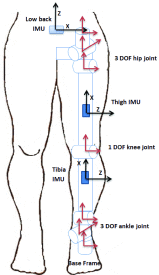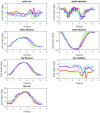Automated Assessment of Dynamic Knee Valgus and Risk of Knee Injury During the Single Leg Squat
- PMID: 29204327
- PMCID: PMC5706595
- DOI: 10.1109/JTEHM.2017.2736559
Automated Assessment of Dynamic Knee Valgus and Risk of Knee Injury During the Single Leg Squat
Abstract
Many clinical assessment protocols of the lower limb rely on the evaluation of functional movement tests such as the single leg squat (SLS), which are often assessed visually. Visual assessment is subjective and depends on the experience of the clinician. In this paper, an inertial measurement unit (IMU)-based method for automated assessment of squat quality is proposed to provide clinicians with a quantitative measure of SLS performance. A set of three IMUs was used to estimate the joint angles, velocities, and accelerations of the squatting leg. Statistical time domain features were generated from these measurements. The most informative features were used for classifier training. A data set of SLS performed by healthy participants was collected and labeled by three expert clinical raters using two different labeling criteria: "observed amount of knee valgus" and "overall risk of injury". The results showed that both flexion at the hip and knee, as well as hip and ankle internal rotation are discriminative features, and that participants with "poor" squats bend the hip and knee less than those with better squat performance. Furthermore, improved classification performance is achieved for females by training separate classifiers stratified by gender. Classification results showed excellent accuracy, 95.7 % for classifying squat quality as "poor" or "good" and 94.6% for differentiating between high and no risk of injury.
Keywords: Human motion analysis; classification; feature selection; inertial measurement unit; motion assessment protocols; single leg squat.
Figures





References
-
- Hattam P. and Smeatham A., Special Tests in Musculoskeletal Examination: An Evidence-Based Guide for Clinicians. Amsterdam, The Netherlands: Elsevier, 2010.
-
- Gornitzky A. L., Lott A., Yellin J. L., Fabricant P. D., Lawrence J. T., and Ganley T. J., “Sport-specific yearly risk and incidence of anterior cruciate ligament tears in high school athletes: A systematic review and meta-analysis,” Amer. J. Sports Med., vol. 44, no. 10, pp. 2716–2723, 2016. - PubMed
LinkOut - more resources
Full Text Sources
Other Literature Sources

